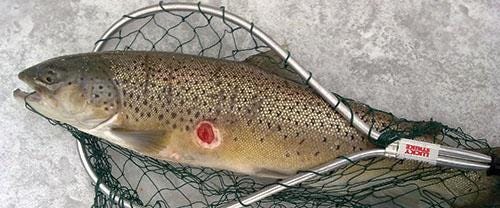Deeper Dive: What's at Stake with Sea Lampreys
DOGE Staff Cuts Threaten Michigan Recreational Fishing and Tourist Industry
As part of the sweeping February firings of “probationary” federal government staff, 12 Fish and Wildlife Service and 2 Geological Survey personnel based in Michigan, and who conduct critical tasks essential for keeping the invasive sea lamprey in check in the Great Lakes, were dismissed. Further inhibiting control efforts is the freeze on hiring seasonal workers who dose the Great Lakes rivers and tributaries to kill larval sea lamprey. The dosing program initiates in April. These Michigan based staff are part of a collaborative binational team from the United States and Canada, coordinated by the Great Lakes Fishery Commission.
The Commission was established in the 1950’s in response to the near total collapse of the fishing industry due to the explosion of sea lamprey and their voracious appetites. Sea lamprey entered the Great Lakes from the Atlantic Ocean in the early 1800’s and first recorded in Lake Ontario in 1835. Niagara Falls created a natural barrier, keeping the sea lamprey out of the other four Great Lakes. Ever-widened shipping lanes bypassing the Falls created an easy highway for the sea lampreys to invade the rest of the Great Lakes basin.
Sea lampreys are eel-like creatures with sucker-like mouths that latch onto fish and drain their bodily fluids. They prey on most species of large Great Lakes fish such as lake trout, brown trout, lake sturgeon, lake whitefish, ciscoes, burbot, walleye, catfish, and Pacific salmonids including Chinook and coho salmon and rainbow trout/steelhead. One lamprey can consume 40 pounds of fish over its two- to three-year lifecycle. Fish that are attacked most often die as a result, either from the direct attack or from infection of the wound left behind. Those that survive an attack are often compromised due to severe weight loss and overall reduced health.
Quick facts from the Great Lakes Fishery Commission website:
The Great Lakes fishery is worth more than $7 billion annually.
The fishery supports 75,000 jobs, in addition to hundreds of thousands of jobs related to tourism, navigation, etc.
More than 5 million people fish the Great Lakes annually.
Commercial fishing is the backbone of many Great Lakes communities. Charter fishing is an important business.
Subsistence fishing is a right and a way of life for tribal and aboriginal communities.
Before the sea lamprey invasion, Canada and the United States harvested about 15 million pounds of lake trout in the upper Great Lakes each year. By the late 1940s, sea lamprey populations had exploded, and by the early 1960s, the catch had declined precipitously, to approximately 300,000 pounds, about 2% of the previous average.
Sea lamprey are controlled primarily through application of pesticide that target their larval stage in creeks and rivers throughout the Great Lakes basin. A single adult female sea lamprey can lay around 100,000 eggs, of which 10 percent hatch into larvae that burrow into the stream bed and live for 3 to 10 years. Larvae emerge from the stream beds and make their way back into the lakes to feed for 12 to 18 months before migrating back up streams to start the cycle again. Preventing the larvae from maturing and entering back into the Great Lakes as parasitic juveniles breaks the lifecycle and keeps sea lamprey populations in check and thus fish populations safe from attack. Skipping an entire lamprey treatment season would allow approximately 4.5 million female lamprey to produce approximately 450 billion eggs.
The pesticides, or lampricides, most often used is 3-trifluoromethyl-4-nitrophenol (TFM) and niclosamide, which kill the larvae while not significantly harming other, non-target aquatic organisms. Applications to infested river systems are done every three to five years by trained, certified staff. Treatments have been conducted for over 60 years and have brought the sea lamprey population down 90 percent in most of the Great Lakes from the disastrous 1950’s. Disruption to the treatment schedule is demonstrably problematic. During the COVID-19 pandemic, 2020 and 2021 pesticide applications were reduced and sea lamprey populations spiked. Fortunately, with resumed prevention activities, the populations trended down again.
Recreational fishing in Michigan is a multi-million-dollar tourist industry and part of a $5.1 billion dollar industry for the region including across the eight Great Lakes states and Ontario. The Commission receives approximately $20 million U.S. annually from Washington and about $8.5 million Cdn. from Canada - a funding formula based on the share of the lakes in each country's territory. The Commission employs approximately 85 staff to implement the tasks required to have an adequately robust prevention program to hold the sea lamprey population in check. Trained full-time staff and part-time or seasonal staff not only are necessary for wide-scale application, but also to construct and maintain barriers, capture, and conducting ongoing research. Cooperation financially and staffing levels is critical to the success of the sea lamprey control program given that what happens, or doesn’t happen, in one region affects the whole Great Lakes basin.
Between the late 1800s and the 1950s, the eight bordering states and Ontario tried no fewer than 40 times to create a lasting mechanism for cooperation, or at least to harmonize their fishery regulations. For multiple reasons, these efforts failed. Then the sea lamprey explosion and its related impacts hit and propelled great cooperation with heightened recognition of a basin-wide problem. Moreover, government resources from both nations would be needed to overcome the sea lamprey problem. The 1954 Convention on Great Lakes Fisheries—a treaty between Canada and the United States—created the Great Lakes Fishery Commission to control sea lampreys, advance science, and help agencies work together.
Now, with current cuts in staffing and the national budget, "Our program (to control sea lamprey) is in serious peril." Greg McClinchey, legislative affairs and policy director of the Great Lakes Fishery Commission.

Interested in more history and information? Check out the new documentary, The Fish Thief, or visit the Great Lakes Fishery Commission website.
What you can do:
Call your state representatives and ask them if they are aware of this threat to Michigan tourism and fishing due to staffing cuts and freezes, and what they plan to do about it?
Call your Congressional Representative and Senators and tell them to immediately demand restoration of those key full-time and seasonal staff to critical seal lamprey control efforts due to launch in April.





